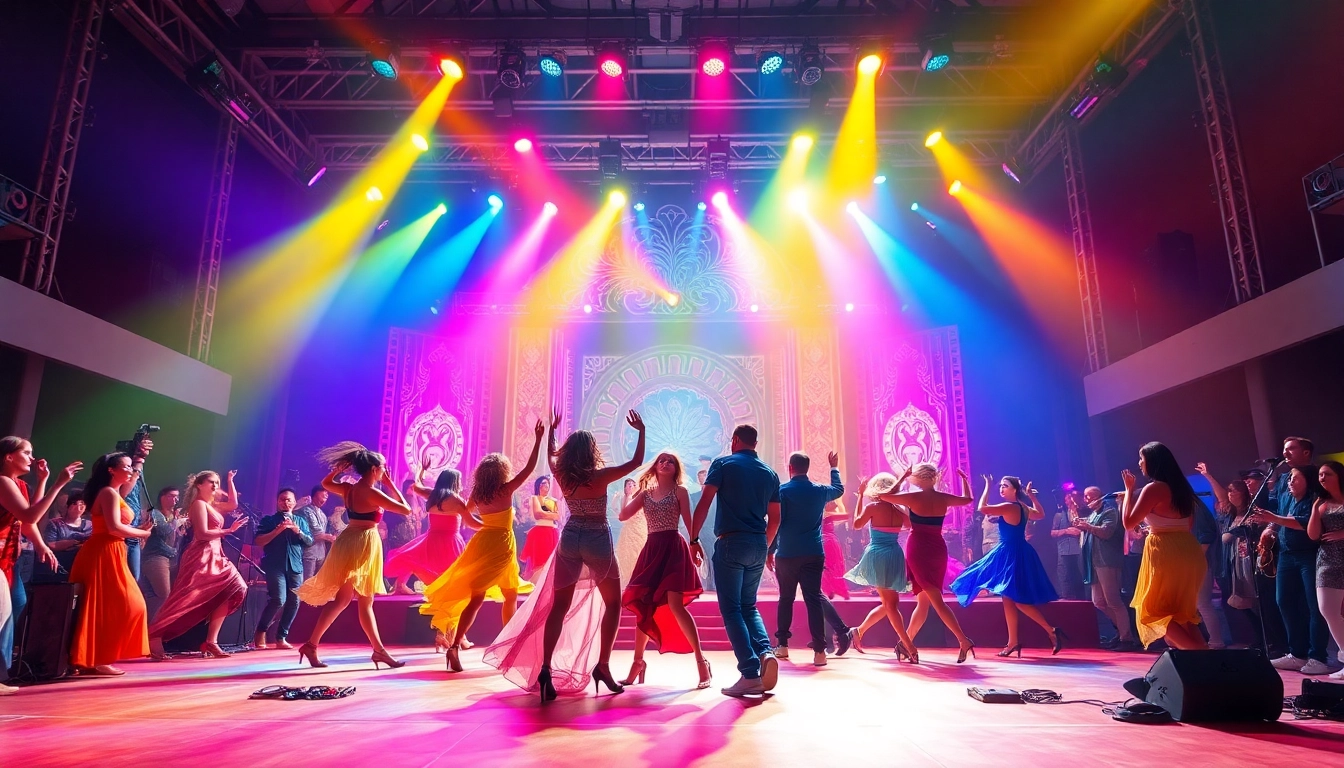Understanding the Essence of Stage Shows
Stage shows are a timeless form of entertainment that bring stories to life through performance. These artistic expressions have the power to engage, inspire, and entertain audiences, creating experiences that linger long after the curtain falls. From musicals to dramatic plays, stage shows encompass a vast expanse of genres and styles, showcasing the creativity and talents of performers, writers, and directors alike. As we delve into the world of stage shows, we will explore their history, key elements, and the vibrant genres that captivate audiences globally.
The History and Evolution of Stage Shows
The roots of stage shows can be traced back to ancient civilizations where storytelling was conveyed through ritual and performance. The Greeks and Romans established early theatrical formats that have influenced modern theatre. From the plays of Sophocles and Aristophanes to the grandeur of Shakespearean theatre, the evolution of stage shows is marked by cultural shifts and technological advancements.
Throughout history, stage shows have evolved dramatically. The rise of opera in the 16th century, the birth of musical theatre in the 19th century, and the revolutionary impact of Broadway in the 20th century have all contributed to a rich tapestry of performance art. Today, these performances are more varied and inclusive, blending different genres and integrating multicultural influences that reflect contemporary society.
Key Elements that Define Stage Shows
At the heart of every stage show lie several key elements that define their impact and success:
- Storytelling: Every show begins with a story that connects with the audience. Whether it’s a heartwarming tale or a gripping drama, storytelling is the backbone of an engaging performance.
- Acting: The talents of actors bring characters to life. Their ability to emote and engage with the audience is crucial for the effectiveness of a performance.
- Direction: A director shapes the vision of the show, orchestrating the performances, staging, and pacing to create a cohesive experience.
- Music and Sound: Whether it’s a haunting score or lively musical numbers, the audio elements of stage shows enhance emotions and enhance storytelling.
- Set Design: The visual elements of a stage show, including scenery and props, contribute to the overall aesthetic and immersion of the performance.
Popular Genres of Stage Shows
Stage shows encompass a wide array of genres, each with its unique appeal. Some of the most popular genres include:
- Musicals: Combining songs, spoken dialogue, and dance, musicals are vibrant performances that capture a range of emotions.
- Plays: From classic tragedies to modern dramas, plays focus on dialogue and character interactions, often exploring profound themes and societal issues.
- Dance Shows: These performances emphasize choreography and physical expression, often telling a story through movement.
- Cabaret: A blend of music, dance, and theatrical performance often performed in a nightclub setting, cabaret shows offer a more intimate and interactive experience.
- Pantomimes: Predominantly popular in the UK, pantomimes are family-friendly performances that often involve audience participation and whimsical storytelling.
What Makes Stage Shows Engaging for Audiences
The essence of stage shows lies not just in the performance itself but in their ability to captivate and resonate with audiences. Several factors contribute to this engagement.
The Role of Storytelling in Stage Shows
Storytelling is the lifeblood of stage shows. A compelling narrative can enthrall audiences, drawing them into the lives of characters and the worlds they inhabit. Well-crafted stories evoke emotional responses, allowing audiences to laugh, cry, and reflect, creating a shared experience that etches memories in their minds.
A successful stage show often employs universal themes—love, loss, triumph, and conflict—that transcend cultural boundaries. It’s these relatable narratives that forge a connection between the performers and the audience, making the experience not just one of passive observation but active participation in the unfolding drama.
Interactive Elements in Stage Shows
Increasingly, stage shows are incorporating interactive elements that enhance audience engagement. Techniques such as breaking the fourth wall, inviting audience participation, and creating immersive experiences heighten the excitement and drama of live performances.
For example, some productions allow audience members to influence the outcome of the story through their choices, making each performance unique. This level of interaction fosters a deeper connection and engagement, as attendees feel they are part of the show’s narrative rather than just observers.
Use of Technology to Enhance Stage Shows
Technology plays a pivotal role in the evolution of stage shows, providing innovative ways to enhance storytelling and audience engagement. From advanced lighting and sound systems to projection mapping and virtual reality, the integration of technology creates immersive experiences that were once unimaginable.
Modern stage shows often utilize dynamic visual effects that complement the narrative and emotional tone of the performance. This not only captivates the audience but also enhances their immersion in the story being told. The seamless combination of traditional performance art with cutting-edge technology represents the future of stage shows, making them more accessible and appealing to diverse audiences.
Behind the Scenes: The Production of Stage Shows
The magic of stage shows doesn’t just happen on stage; it involves meticulous planning, collaboration, and creativity behind the scenes. Understanding this production process is essential for those aspiring to enter the world of performing arts.
Choosing the Right Venue for Stage Shows
When producing a stage show, selecting the appropriate venue is crucial. The venue affects everything from the staging and set design to the audience’s overall experience. Factors to consider when choosing a venue include:
- Capacity: The venue must accommodate the expected audience size comfortably.
- Layout: The design of the stage and seating arrangement impacts visibility and acoustics.
- Technical Facilities: Ensure the venue has the necessary technical equipment, such as lighting and sound systems, to support the production.
- Location: The venue’s accessibility can significantly influence ticket sales and audience turnout.
Assembling a Talented Cast for Stage Shows
An engaging production hinges on the talents of its cast. Casting calls are essential to find actors who resonate with the characters and bring the script to life. Directors must look for actors with strong performances that can connect emotionally with an audience.
Moreover, chemistry among cast members plays a vital role in creating believable relationships on stage. Rehearsals are critical for fostering this chemistry and ensuring that the actors are well-prepared to deliver a captivating performance.
Stage Design and Set Construction for Stage Shows
The set design is a visual representation of the story’s world and is fundamental in helping audiences suspend disbelief. Designers work closely with directors to create environments that enhance the narrative while also considering practical elements such as changing scenes and transitions.
Set construction involves meticulous planning, collaboration with skilled carpenters and decorators, and the integration of props and backdrops that reflect the show’s aesthetic. The result is a cohesively designed performance space that immerses audiences in the story.
Marketing and Promotion Strategies for Stage Shows
Once a stage show is ready for production, marketing and promotion become vital for its success. Effective strategies can create buzz and drive ticket sales, ensuring the show reaches its target audience.
Identifying Target Audiences for Stage Shows
A vital first step in marketing a stage show is to identify the target audience. Understanding demographics, preferences, and behavior allows marketers to tailor their messaging effectively. Researching past performances, conducting surveys, and analyzing social media engagement can provide valuable insights into the audience’s interests.
Segmentation of the audience can also help in crafting targeted promotional efforts, ensuring that the right messages reach the right people. For instance, a show designed for families with children will require a different approach than a dramatic play aimed at adult audiences.
Effective Social Media Campaigns for Stage Shows
In the digital age, social media serves as a powerful tool for promoting stage shows. Engaging with potential audiences through platforms such as Facebook, Twitter, Instagram, and TikTok enables promotional teams to create excitement and reach wider audiences.
Content such as behind-the-scenes footage, interviews with cast members, and teaser trailers can build anticipation. Additionally, using countdowns, live Q&A sessions, and interactive posts encourages audience interaction and participation, fostering a community around the production.
Building Buzz: Pre-Show Promotions for Stage Shows
Pre-show promotions, such as previews and exclusive events, can generate excitement before the opening night. Hosting VIP preview performances for select audiences, including influencers and local media, often leads to valuable word-of-mouth buzz.
Engaging local businesses for cross-promotion, such as discounts on tickets for customers of certain establishments, also helps expand reach and attract new audiences. Leveraging innovative marketing approaches, like contests or giveaways, serves to motivate potential attendees and drive ticket sales.
Measuring Success and Impact of Stage Shows
Measuring the success of a stage show goes beyond ticket sales; it involves analyzing audience reception, feedback, and overall impact. Understanding these metrics can guide future productions and marketing efforts.
Feedback and Audience Reception of Stage Shows
Gathering feedback from audiences post-performance is essential in assessing reception. This can include surveys, social media comments, and reviews on platforms dedicated to arts and entertainment.
Analyzing audience reactions can provide insights into what resonated well and what could be improved. Understanding audience demographics can also help contextualize feedback, guiding future creative decisions.
Analyzing Revenue and Ticket Sales for Stage Shows
Revenue analysis is crucial for assessing the financial viability of a production. Metrics such as ticket sales, production costs, and profit margins offer insights into the economic success of the show.
Comparing projected sales to actual figures can inform planning for future productions. Identifying peak performance times and audience turnout can assist in strategizing future marketing campaigns and pricing policies.
The Future of Stage Shows: Trends to Watch
The world of stage shows is continually evolving. Emerging trends include more immersive and interactive performances, the incorporation of diverse narratives that reflect global cultures, and a growing environmental consciousness impacting production choices.
Furthermore, advancements in technology will likely continue to reshape performances, with virtual reality and augmented reality paving the way for new interactive storytelling formats. The future promises an exciting landscape, allowing stage shows to maintain their relevance and appeal to new generations of audiences.

